Cardiovascular and Respiratory Diseases: Module 1 Report
VerifiedAdded on 2022/08/10
|11
|2896
|34
Report
AI Summary
This report examines the pathophysiology of cardiovascular and respiratory diseases, highlighting their interconnectedness and impact on bodily functions. It analyzes two selected articles and a third article to understand the risk factors, including lifestyle choices, oxidative stress, and specific populations like sexual minorities. The report discusses the role of MiR-222 as a biomarker and potential therapeutic target. It also explores the influence of these readings on the author's understanding of cardiovascular disease, emphasizing the importance of reliable medical resources, such as the CDC website. The report concludes with the key takeaways, which include the impact of lifestyle improvements, the significance of MiR-222, and the reduction of oxidative stress to mitigate cardiovascular disease risks.
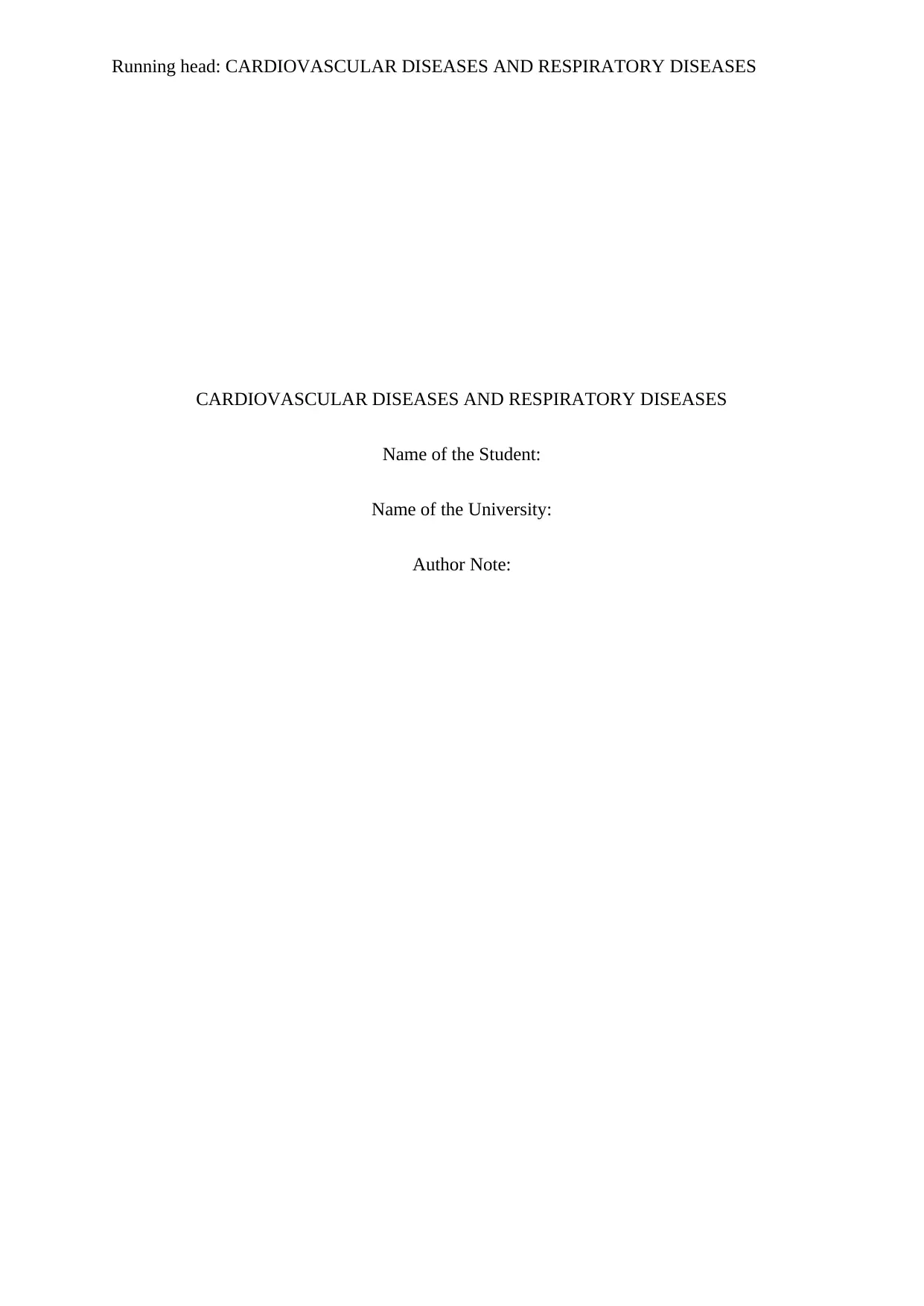
Running head: CARDIOVASCULAR DISEASES AND RESPIRATORY DISEASES
CARDIOVASCULAR DISEASES AND RESPIRATORY DISEASES
Name of the Student:
Name of the University:
Author Note:
CARDIOVASCULAR DISEASES AND RESPIRATORY DISEASES
Name of the Student:
Name of the University:
Author Note:
Paraphrase This Document
Need a fresh take? Get an instant paraphrase of this document with our AI Paraphraser
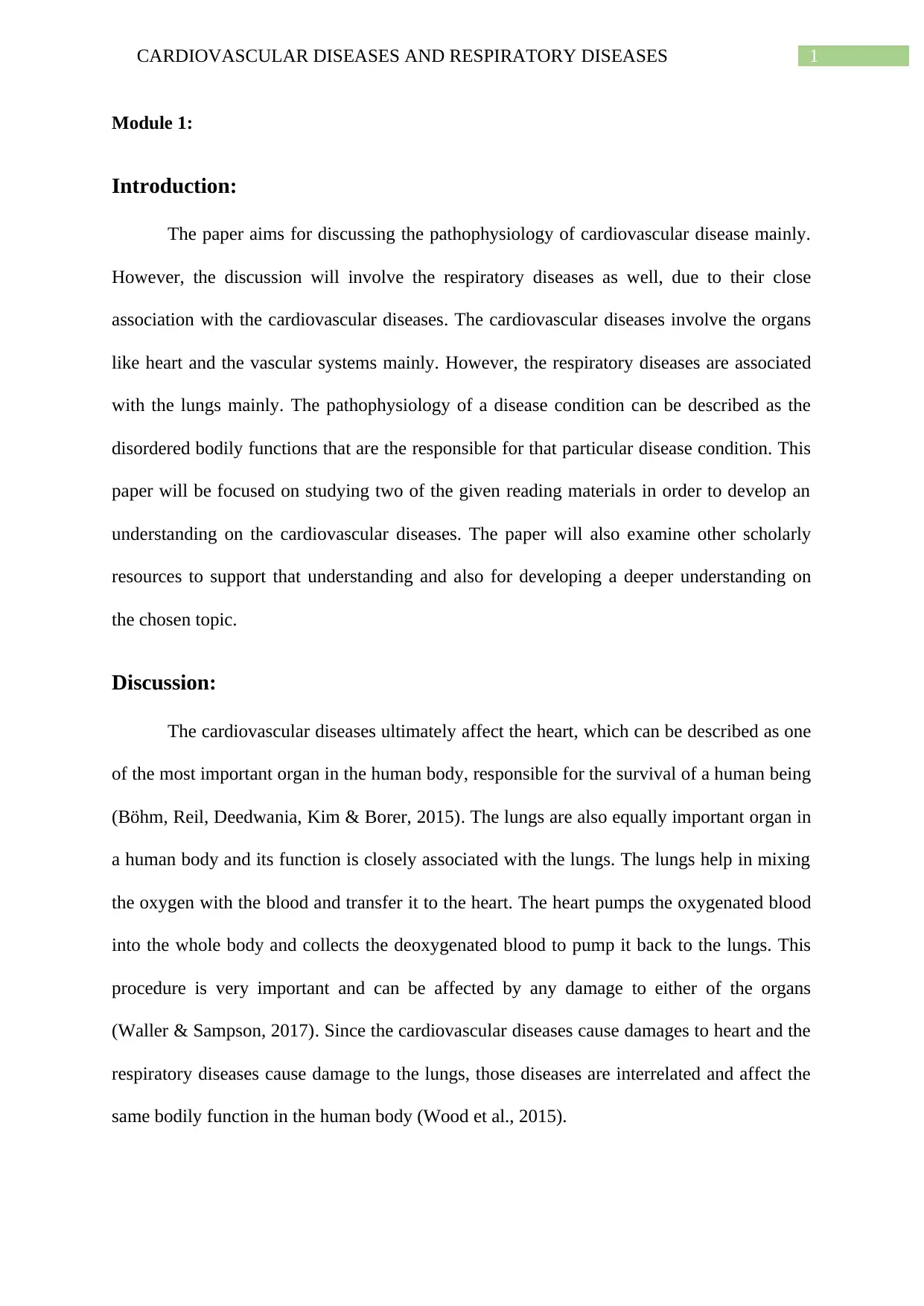
1CARDIOVASCULAR DISEASES AND RESPIRATORY DISEASES
Module 1:
Introduction:
The paper aims for discussing the pathophysiology of cardiovascular disease mainly.
However, the discussion will involve the respiratory diseases as well, due to their close
association with the cardiovascular diseases. The cardiovascular diseases involve the organs
like heart and the vascular systems mainly. However, the respiratory diseases are associated
with the lungs mainly. The pathophysiology of a disease condition can be described as the
disordered bodily functions that are the responsible for that particular disease condition. This
paper will be focused on studying two of the given reading materials in order to develop an
understanding on the cardiovascular diseases. The paper will also examine other scholarly
resources to support that understanding and also for developing a deeper understanding on
the chosen topic.
Discussion:
The cardiovascular diseases ultimately affect the heart, which can be described as one
of the most important organ in the human body, responsible for the survival of a human being
(Böhm, Reil, Deedwania, Kim & Borer, 2015). The lungs are also equally important organ in
a human body and its function is closely associated with the lungs. The lungs help in mixing
the oxygen with the blood and transfer it to the heart. The heart pumps the oxygenated blood
into the whole body and collects the deoxygenated blood to pump it back to the lungs. This
procedure is very important and can be affected by any damage to either of the organs
(Waller & Sampson, 2017). Since the cardiovascular diseases cause damages to heart and the
respiratory diseases cause damage to the lungs, those diseases are interrelated and affect the
same bodily function in the human body (Wood et al., 2015).
Module 1:
Introduction:
The paper aims for discussing the pathophysiology of cardiovascular disease mainly.
However, the discussion will involve the respiratory diseases as well, due to their close
association with the cardiovascular diseases. The cardiovascular diseases involve the organs
like heart and the vascular systems mainly. However, the respiratory diseases are associated
with the lungs mainly. The pathophysiology of a disease condition can be described as the
disordered bodily functions that are the responsible for that particular disease condition. This
paper will be focused on studying two of the given reading materials in order to develop an
understanding on the cardiovascular diseases. The paper will also examine other scholarly
resources to support that understanding and also for developing a deeper understanding on
the chosen topic.
Discussion:
The cardiovascular diseases ultimately affect the heart, which can be described as one
of the most important organ in the human body, responsible for the survival of a human being
(Böhm, Reil, Deedwania, Kim & Borer, 2015). The lungs are also equally important organ in
a human body and its function is closely associated with the lungs. The lungs help in mixing
the oxygen with the blood and transfer it to the heart. The heart pumps the oxygenated blood
into the whole body and collects the deoxygenated blood to pump it back to the lungs. This
procedure is very important and can be affected by any damage to either of the organs
(Waller & Sampson, 2017). Since the cardiovascular diseases cause damages to heart and the
respiratory diseases cause damage to the lungs, those diseases are interrelated and affect the
same bodily function in the human body (Wood et al., 2015).
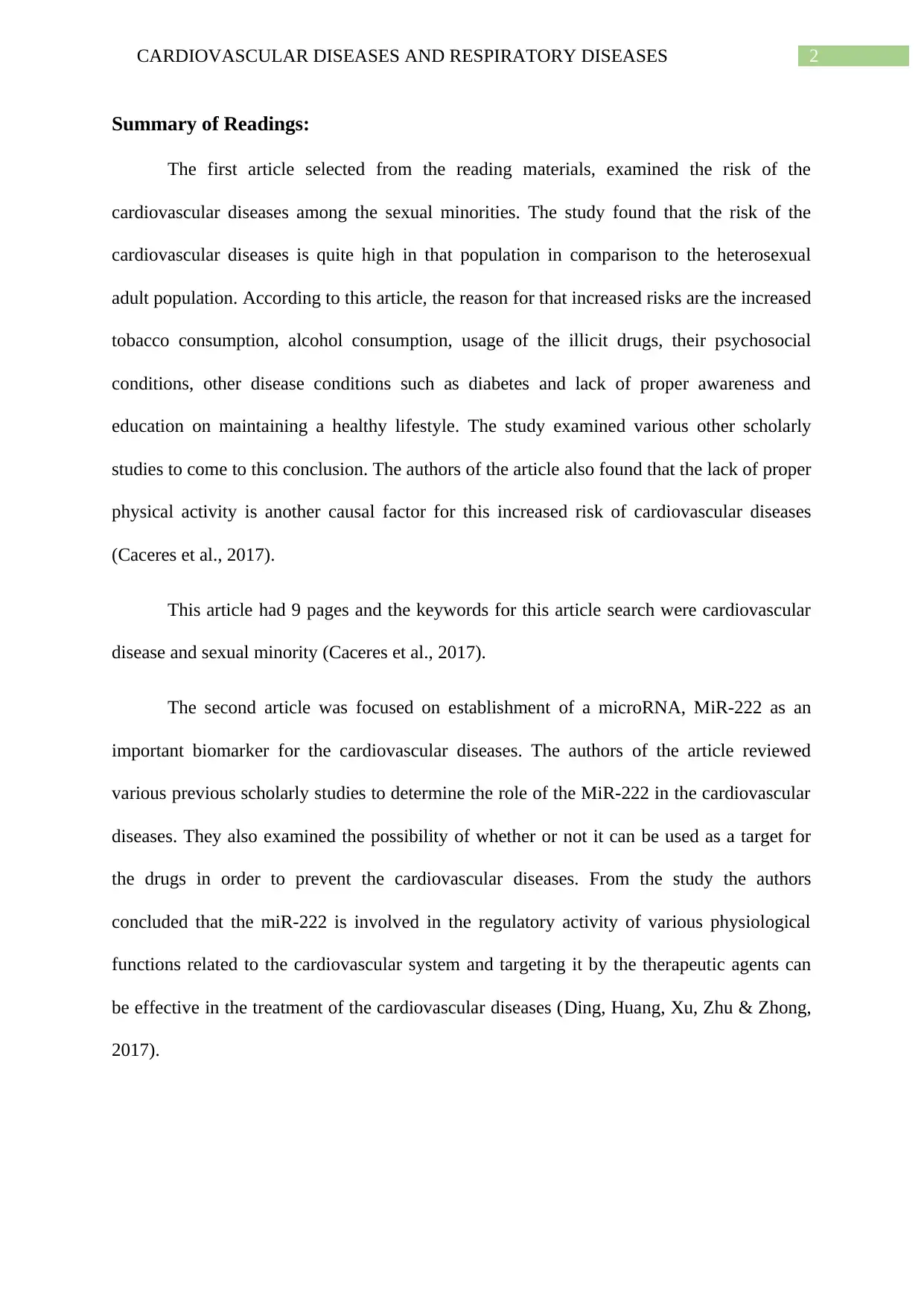
2CARDIOVASCULAR DISEASES AND RESPIRATORY DISEASES
Summary of Readings:
The first article selected from the reading materials, examined the risk of the
cardiovascular diseases among the sexual minorities. The study found that the risk of the
cardiovascular diseases is quite high in that population in comparison to the heterosexual
adult population. According to this article, the reason for that increased risks are the increased
tobacco consumption, alcohol consumption, usage of the illicit drugs, their psychosocial
conditions, other disease conditions such as diabetes and lack of proper awareness and
education on maintaining a healthy lifestyle. The study examined various other scholarly
studies to come to this conclusion. The authors of the article also found that the lack of proper
physical activity is another causal factor for this increased risk of cardiovascular diseases
(Caceres et al., 2017).
This article had 9 pages and the keywords for this article search were cardiovascular
disease and sexual minority (Caceres et al., 2017).
The second article was focused on establishment of a microRNA, MiR-222 as an
important biomarker for the cardiovascular diseases. The authors of the article reviewed
various previous scholarly studies to determine the role of the MiR-222 in the cardiovascular
diseases. They also examined the possibility of whether or not it can be used as a target for
the drugs in order to prevent the cardiovascular diseases. From the study the authors
concluded that the miR-222 is involved in the regulatory activity of various physiological
functions related to the cardiovascular system and targeting it by the therapeutic agents can
be effective in the treatment of the cardiovascular diseases (Ding, Huang, Xu, Zhu & Zhong,
2017).
Summary of Readings:
The first article selected from the reading materials, examined the risk of the
cardiovascular diseases among the sexual minorities. The study found that the risk of the
cardiovascular diseases is quite high in that population in comparison to the heterosexual
adult population. According to this article, the reason for that increased risks are the increased
tobacco consumption, alcohol consumption, usage of the illicit drugs, their psychosocial
conditions, other disease conditions such as diabetes and lack of proper awareness and
education on maintaining a healthy lifestyle. The study examined various other scholarly
studies to come to this conclusion. The authors of the article also found that the lack of proper
physical activity is another causal factor for this increased risk of cardiovascular diseases
(Caceres et al., 2017).
This article had 9 pages and the keywords for this article search were cardiovascular
disease and sexual minority (Caceres et al., 2017).
The second article was focused on establishment of a microRNA, MiR-222 as an
important biomarker for the cardiovascular diseases. The authors of the article reviewed
various previous scholarly studies to determine the role of the MiR-222 in the cardiovascular
diseases. They also examined the possibility of whether or not it can be used as a target for
the drugs in order to prevent the cardiovascular diseases. From the study the authors
concluded that the miR-222 is involved in the regulatory activity of various physiological
functions related to the cardiovascular system and targeting it by the therapeutic agents can
be effective in the treatment of the cardiovascular diseases (Ding, Huang, Xu, Zhu & Zhong,
2017).
⊘ This is a preview!⊘
Do you want full access?
Subscribe today to unlock all pages.

Trusted by 1+ million students worldwide

3CARDIOVASCULAR DISEASES AND RESPIRATORY DISEASES
The article had 7 pages and the keywords were cardiovascular diseases, MiR-222,
pathology of cardiovascular diseases and physiology of the cardiovascular diseases (Ding,
Huang, Xu, Zhu & Zhong, 2017).
The third article was focused on determining the effect of oxidative stress on the
cardiovascular health. The paper discussed the possible factors that are responsible for the
increase in the oxidative stress, including the disease conditions like diabetes and obesity
along with the other factors such as the habits of smoking and air pollution. Oxidative stress
occurs in case of increased level of reactive oxygen species (ROS) in the body, which was
selected as a key factor for causing the cardiovascular risks in this study. The study also
associated smoking and environmental pollution with the cardiovascular disease risks. Both
of the factors are directly responsible for causing respiratory disease mainly but in turn they
present risks for the cardiovascular diseases (Niemann et al., 2017).
The article had 22 pages and the keyword used for searching this study was risks of
cardiovascular diseases (Niemann et al., 2017).
A Link to the Reading:
The cardiovascular diseases involve the diseases that affect the normal functions of
the heart. The functions of the heart are affected, when the blood flow to the heart or from the
heart is affected (Cdc.gov, 2020). The situation can be resulting from blockage in the blood
vessels due to the development of plaque or high blood pressure, which forces the vessels to
burst. The plaque collection in the vessel walls result from the high cholesterol in the blood.
The disease condition is known as atherosclerosis (Yeboah et al., 2016). The individuals with
obesity are at high risk of developing this condition and thus are at risk of developing the
cardiovascular diseases. In case of diabetic individuals, the blood vessels are damaged by the
high glucose content in the blood. The people who have the habit of smoking, their lungs are
The article had 7 pages and the keywords were cardiovascular diseases, MiR-222,
pathology of cardiovascular diseases and physiology of the cardiovascular diseases (Ding,
Huang, Xu, Zhu & Zhong, 2017).
The third article was focused on determining the effect of oxidative stress on the
cardiovascular health. The paper discussed the possible factors that are responsible for the
increase in the oxidative stress, including the disease conditions like diabetes and obesity
along with the other factors such as the habits of smoking and air pollution. Oxidative stress
occurs in case of increased level of reactive oxygen species (ROS) in the body, which was
selected as a key factor for causing the cardiovascular risks in this study. The study also
associated smoking and environmental pollution with the cardiovascular disease risks. Both
of the factors are directly responsible for causing respiratory disease mainly but in turn they
present risks for the cardiovascular diseases (Niemann et al., 2017).
The article had 22 pages and the keyword used for searching this study was risks of
cardiovascular diseases (Niemann et al., 2017).
A Link to the Reading:
The cardiovascular diseases involve the diseases that affect the normal functions of
the heart. The functions of the heart are affected, when the blood flow to the heart or from the
heart is affected (Cdc.gov, 2020). The situation can be resulting from blockage in the blood
vessels due to the development of plaque or high blood pressure, which forces the vessels to
burst. The plaque collection in the vessel walls result from the high cholesterol in the blood.
The disease condition is known as atherosclerosis (Yeboah et al., 2016). The individuals with
obesity are at high risk of developing this condition and thus are at risk of developing the
cardiovascular diseases. In case of diabetic individuals, the blood vessels are damaged by the
high glucose content in the blood. The people who have the habit of smoking, their lungs are
Paraphrase This Document
Need a fresh take? Get an instant paraphrase of this document with our AI Paraphraser
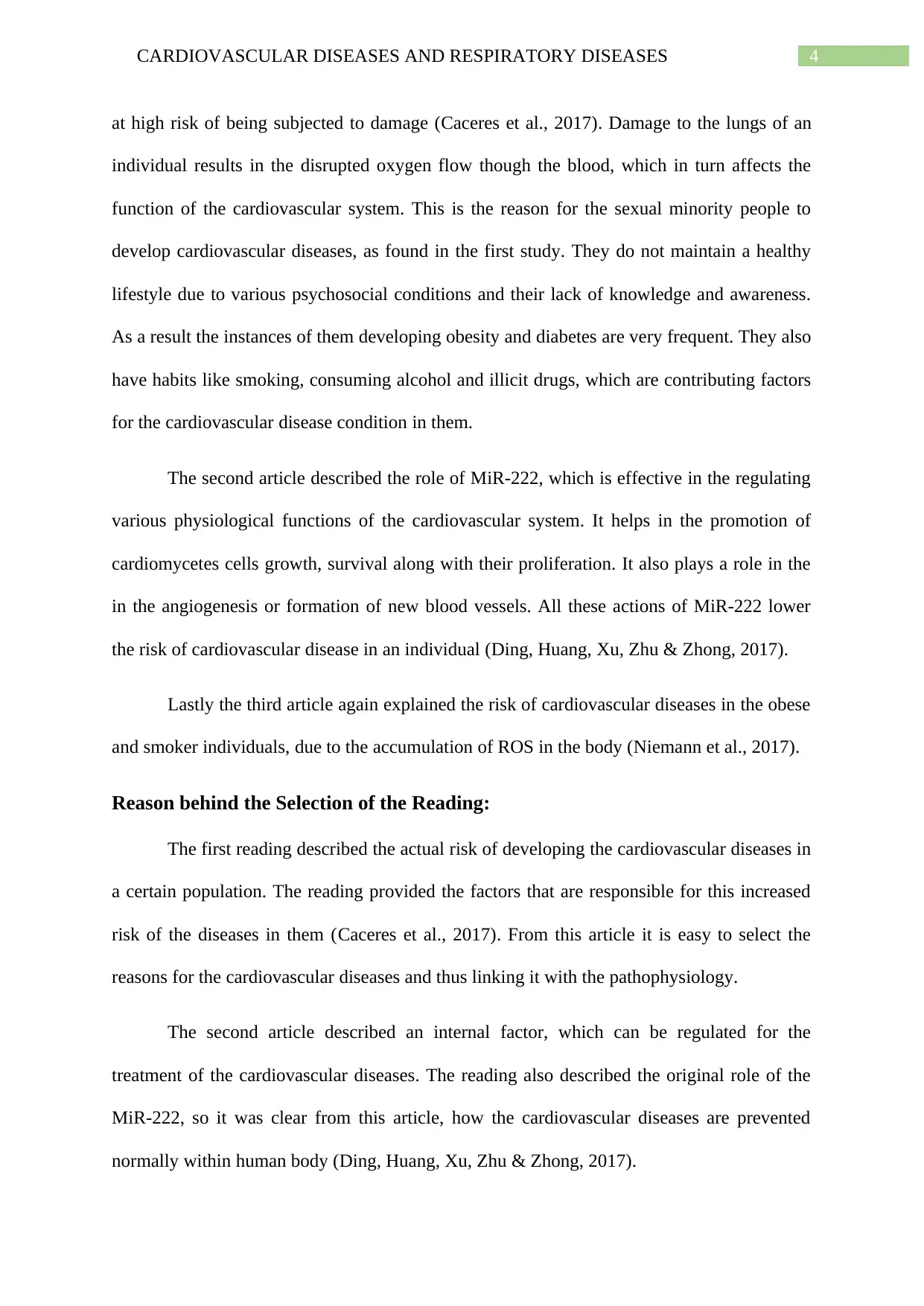
4CARDIOVASCULAR DISEASES AND RESPIRATORY DISEASES
at high risk of being subjected to damage (Caceres et al., 2017). Damage to the lungs of an
individual results in the disrupted oxygen flow though the blood, which in turn affects the
function of the cardiovascular system. This is the reason for the sexual minority people to
develop cardiovascular diseases, as found in the first study. They do not maintain a healthy
lifestyle due to various psychosocial conditions and their lack of knowledge and awareness.
As a result the instances of them developing obesity and diabetes are very frequent. They also
have habits like smoking, consuming alcohol and illicit drugs, which are contributing factors
for the cardiovascular disease condition in them.
The second article described the role of MiR-222, which is effective in the regulating
various physiological functions of the cardiovascular system. It helps in the promotion of
cardiomycetes cells growth, survival along with their proliferation. It also plays a role in the
in the angiogenesis or formation of new blood vessels. All these actions of MiR-222 lower
the risk of cardiovascular disease in an individual (Ding, Huang, Xu, Zhu & Zhong, 2017).
Lastly the third article again explained the risk of cardiovascular diseases in the obese
and smoker individuals, due to the accumulation of ROS in the body (Niemann et al., 2017).
Reason behind the Selection of the Reading:
The first reading described the actual risk of developing the cardiovascular diseases in
a certain population. The reading provided the factors that are responsible for this increased
risk of the diseases in them (Caceres et al., 2017). From this article it is easy to select the
reasons for the cardiovascular diseases and thus linking it with the pathophysiology.
The second article described an internal factor, which can be regulated for the
treatment of the cardiovascular diseases. The reading also described the original role of the
MiR-222, so it was clear from this article, how the cardiovascular diseases are prevented
normally within human body (Ding, Huang, Xu, Zhu & Zhong, 2017).
at high risk of being subjected to damage (Caceres et al., 2017). Damage to the lungs of an
individual results in the disrupted oxygen flow though the blood, which in turn affects the
function of the cardiovascular system. This is the reason for the sexual minority people to
develop cardiovascular diseases, as found in the first study. They do not maintain a healthy
lifestyle due to various psychosocial conditions and their lack of knowledge and awareness.
As a result the instances of them developing obesity and diabetes are very frequent. They also
have habits like smoking, consuming alcohol and illicit drugs, which are contributing factors
for the cardiovascular disease condition in them.
The second article described the role of MiR-222, which is effective in the regulating
various physiological functions of the cardiovascular system. It helps in the promotion of
cardiomycetes cells growth, survival along with their proliferation. It also plays a role in the
in the angiogenesis or formation of new blood vessels. All these actions of MiR-222 lower
the risk of cardiovascular disease in an individual (Ding, Huang, Xu, Zhu & Zhong, 2017).
Lastly the third article again explained the risk of cardiovascular diseases in the obese
and smoker individuals, due to the accumulation of ROS in the body (Niemann et al., 2017).
Reason behind the Selection of the Reading:
The first reading described the actual risk of developing the cardiovascular diseases in
a certain population. The reading provided the factors that are responsible for this increased
risk of the diseases in them (Caceres et al., 2017). From this article it is easy to select the
reasons for the cardiovascular diseases and thus linking it with the pathophysiology.
The second article described an internal factor, which can be regulated for the
treatment of the cardiovascular diseases. The reading also described the original role of the
MiR-222, so it was clear from this article, how the cardiovascular diseases are prevented
normally within human body (Ding, Huang, Xu, Zhu & Zhong, 2017).

5CARDIOVASCULAR DISEASES AND RESPIRATORY DISEASES
The third article mainly linked some environmental factors, behavioural aspects and a
few other disease conditions with the risk of cardiovascular diseases (Niemann et al., 2017).
The reason behind selecting this reading was similar as the first one, which was for an easy
understanding of the pathophysiology of the cardiovascular diseases.
Main point of reading:
The reading was aimed for the development of a better understanding of the risks of
the cardiovascular diseases and the pathophysiology behind these diseases.
How the health deviation alter normal physiology:
According to normal physiology, the heart pumps the oxygenated blood to the whole
body and the deoxygenated blood to the lungs. In case of cardiovascular diseases, those
functions are prevented. In case of heart attack, the blood cannot reach the heart and in case
of stroke the blood does not reach the brain from the heart (Nou, Lo, Hadigan & Grinspoon,
2016).
Key Take away from the readings:
The first reading described that if the behavioural aspects in the sexual minority
groups can be improved; there will be lower instances of cardiovascular diseases in that
population (Caceres et al., 2017).
The second reading identified MiR-222 as a biomarker for the cardiovascular
diseases. The study described various roles of MiR-222 in relation to the cardiovascular
functions. The authors also concluded that this can be used as a therapeutic target for the
treatment of cardiovascular diseases (Ding, Huang, Xu, Zhu & Zhong, 2017).
The third article concluded that lowering the risks of oxidative stress will in turn
lower the risks of cardiovascular diseases in the individuals (Niemann et al., 2017).
The third article mainly linked some environmental factors, behavioural aspects and a
few other disease conditions with the risk of cardiovascular diseases (Niemann et al., 2017).
The reason behind selecting this reading was similar as the first one, which was for an easy
understanding of the pathophysiology of the cardiovascular diseases.
Main point of reading:
The reading was aimed for the development of a better understanding of the risks of
the cardiovascular diseases and the pathophysiology behind these diseases.
How the health deviation alter normal physiology:
According to normal physiology, the heart pumps the oxygenated blood to the whole
body and the deoxygenated blood to the lungs. In case of cardiovascular diseases, those
functions are prevented. In case of heart attack, the blood cannot reach the heart and in case
of stroke the blood does not reach the brain from the heart (Nou, Lo, Hadigan & Grinspoon,
2016).
Key Take away from the readings:
The first reading described that if the behavioural aspects in the sexual minority
groups can be improved; there will be lower instances of cardiovascular diseases in that
population (Caceres et al., 2017).
The second reading identified MiR-222 as a biomarker for the cardiovascular
diseases. The study described various roles of MiR-222 in relation to the cardiovascular
functions. The authors also concluded that this can be used as a therapeutic target for the
treatment of cardiovascular diseases (Ding, Huang, Xu, Zhu & Zhong, 2017).
The third article concluded that lowering the risks of oxidative stress will in turn
lower the risks of cardiovascular diseases in the individuals (Niemann et al., 2017).
⊘ This is a preview!⊘
Do you want full access?
Subscribe today to unlock all pages.

Trusted by 1+ million students worldwide
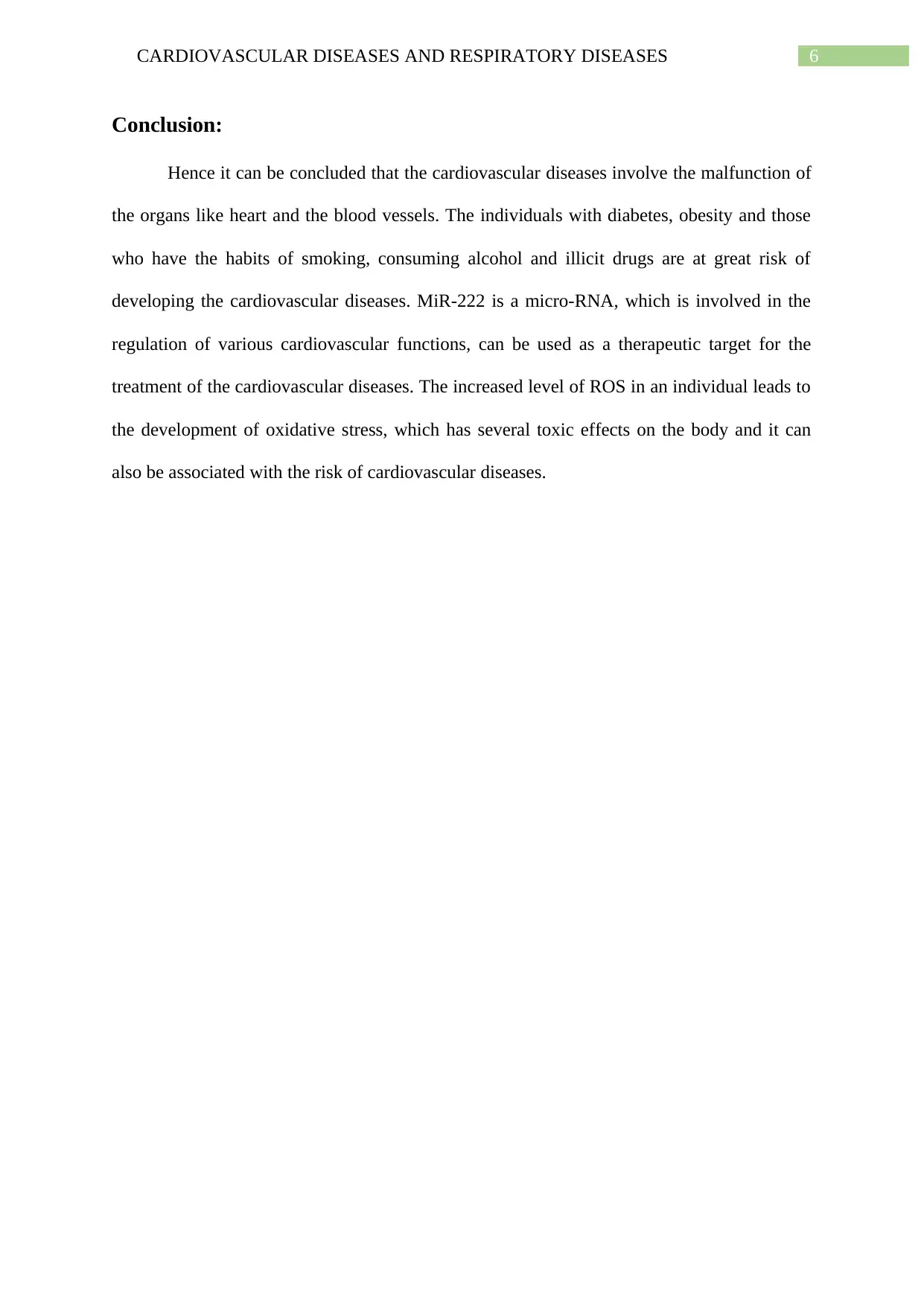
6CARDIOVASCULAR DISEASES AND RESPIRATORY DISEASES
Conclusion:
Hence it can be concluded that the cardiovascular diseases involve the malfunction of
the organs like heart and the blood vessels. The individuals with diabetes, obesity and those
who have the habits of smoking, consuming alcohol and illicit drugs are at great risk of
developing the cardiovascular diseases. MiR-222 is a micro-RNA, which is involved in the
regulation of various cardiovascular functions, can be used as a therapeutic target for the
treatment of the cardiovascular diseases. The increased level of ROS in an individual leads to
the development of oxidative stress, which has several toxic effects on the body and it can
also be associated with the risk of cardiovascular diseases.
Conclusion:
Hence it can be concluded that the cardiovascular diseases involve the malfunction of
the organs like heart and the blood vessels. The individuals with diabetes, obesity and those
who have the habits of smoking, consuming alcohol and illicit drugs are at great risk of
developing the cardiovascular diseases. MiR-222 is a micro-RNA, which is involved in the
regulation of various cardiovascular functions, can be used as a therapeutic target for the
treatment of the cardiovascular diseases. The increased level of ROS in an individual leads to
the development of oxidative stress, which has several toxic effects on the body and it can
also be associated with the risk of cardiovascular diseases.
Paraphrase This Document
Need a fresh take? Get an instant paraphrase of this document with our AI Paraphraser
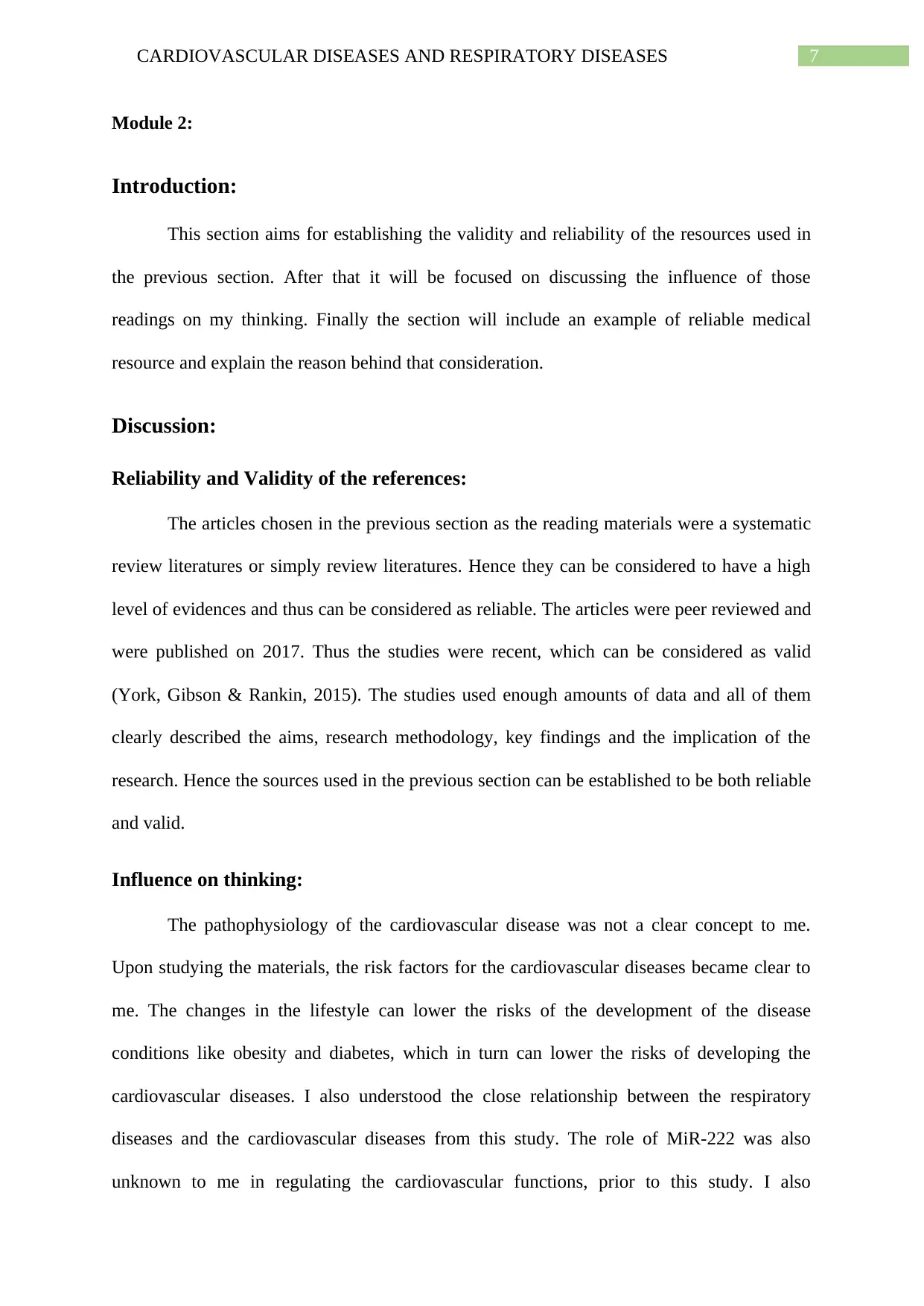
7CARDIOVASCULAR DISEASES AND RESPIRATORY DISEASES
Module 2:
Introduction:
This section aims for establishing the validity and reliability of the resources used in
the previous section. After that it will be focused on discussing the influence of those
readings on my thinking. Finally the section will include an example of reliable medical
resource and explain the reason behind that consideration.
Discussion:
Reliability and Validity of the references:
The articles chosen in the previous section as the reading materials were a systematic
review literatures or simply review literatures. Hence they can be considered to have a high
level of evidences and thus can be considered as reliable. The articles were peer reviewed and
were published on 2017. Thus the studies were recent, which can be considered as valid
(York, Gibson & Rankin, 2015). The studies used enough amounts of data and all of them
clearly described the aims, research methodology, key findings and the implication of the
research. Hence the sources used in the previous section can be established to be both reliable
and valid.
Influence on thinking:
The pathophysiology of the cardiovascular disease was not a clear concept to me.
Upon studying the materials, the risk factors for the cardiovascular diseases became clear to
me. The changes in the lifestyle can lower the risks of the development of the disease
conditions like obesity and diabetes, which in turn can lower the risks of developing the
cardiovascular diseases. I also understood the close relationship between the respiratory
diseases and the cardiovascular diseases from this study. The role of MiR-222 was also
unknown to me in regulating the cardiovascular functions, prior to this study. I also
Module 2:
Introduction:
This section aims for establishing the validity and reliability of the resources used in
the previous section. After that it will be focused on discussing the influence of those
readings on my thinking. Finally the section will include an example of reliable medical
resource and explain the reason behind that consideration.
Discussion:
Reliability and Validity of the references:
The articles chosen in the previous section as the reading materials were a systematic
review literatures or simply review literatures. Hence they can be considered to have a high
level of evidences and thus can be considered as reliable. The articles were peer reviewed and
were published on 2017. Thus the studies were recent, which can be considered as valid
(York, Gibson & Rankin, 2015). The studies used enough amounts of data and all of them
clearly described the aims, research methodology, key findings and the implication of the
research. Hence the sources used in the previous section can be established to be both reliable
and valid.
Influence on thinking:
The pathophysiology of the cardiovascular disease was not a clear concept to me.
Upon studying the materials, the risk factors for the cardiovascular diseases became clear to
me. The changes in the lifestyle can lower the risks of the development of the disease
conditions like obesity and diabetes, which in turn can lower the risks of developing the
cardiovascular diseases. I also understood the close relationship between the respiratory
diseases and the cardiovascular diseases from this study. The role of MiR-222 was also
unknown to me in regulating the cardiovascular functions, prior to this study. I also
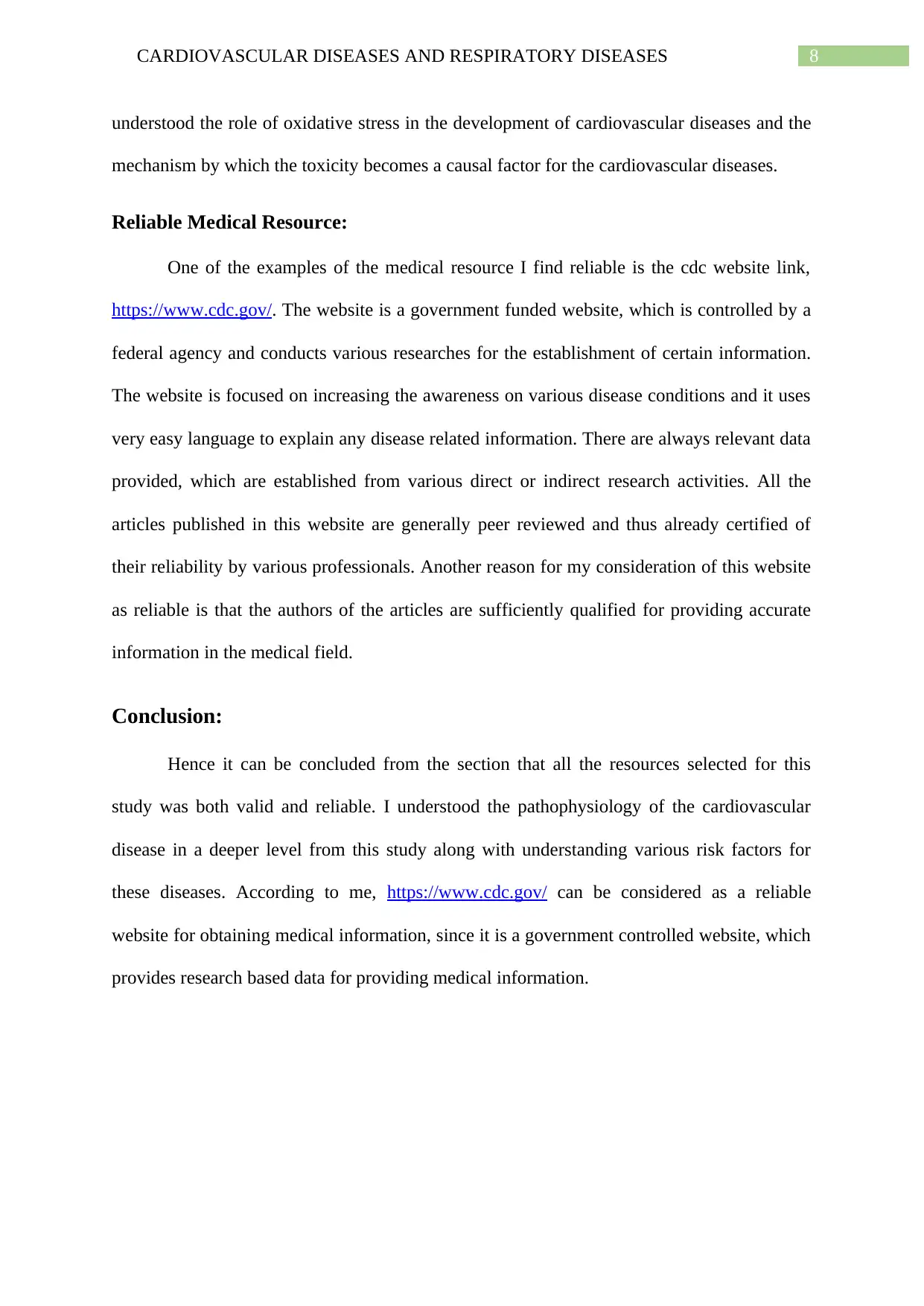
8CARDIOVASCULAR DISEASES AND RESPIRATORY DISEASES
understood the role of oxidative stress in the development of cardiovascular diseases and the
mechanism by which the toxicity becomes a causal factor for the cardiovascular diseases.
Reliable Medical Resource:
One of the examples of the medical resource I find reliable is the cdc website link,
https://www.cdc.gov/. The website is a government funded website, which is controlled by a
federal agency and conducts various researches for the establishment of certain information.
The website is focused on increasing the awareness on various disease conditions and it uses
very easy language to explain any disease related information. There are always relevant data
provided, which are established from various direct or indirect research activities. All the
articles published in this website are generally peer reviewed and thus already certified of
their reliability by various professionals. Another reason for my consideration of this website
as reliable is that the authors of the articles are sufficiently qualified for providing accurate
information in the medical field.
Conclusion:
Hence it can be concluded from the section that all the resources selected for this
study was both valid and reliable. I understood the pathophysiology of the cardiovascular
disease in a deeper level from this study along with understanding various risk factors for
these diseases. According to me, https://www.cdc.gov/ can be considered as a reliable
website for obtaining medical information, since it is a government controlled website, which
provides research based data for providing medical information.
understood the role of oxidative stress in the development of cardiovascular diseases and the
mechanism by which the toxicity becomes a causal factor for the cardiovascular diseases.
Reliable Medical Resource:
One of the examples of the medical resource I find reliable is the cdc website link,
https://www.cdc.gov/. The website is a government funded website, which is controlled by a
federal agency and conducts various researches for the establishment of certain information.
The website is focused on increasing the awareness on various disease conditions and it uses
very easy language to explain any disease related information. There are always relevant data
provided, which are established from various direct or indirect research activities. All the
articles published in this website are generally peer reviewed and thus already certified of
their reliability by various professionals. Another reason for my consideration of this website
as reliable is that the authors of the articles are sufficiently qualified for providing accurate
information in the medical field.
Conclusion:
Hence it can be concluded from the section that all the resources selected for this
study was both valid and reliable. I understood the pathophysiology of the cardiovascular
disease in a deeper level from this study along with understanding various risk factors for
these diseases. According to me, https://www.cdc.gov/ can be considered as a reliable
website for obtaining medical information, since it is a government controlled website, which
provides research based data for providing medical information.
⊘ This is a preview!⊘
Do you want full access?
Subscribe today to unlock all pages.

Trusted by 1+ million students worldwide

9CARDIOVASCULAR DISEASES AND RESPIRATORY DISEASES
References:
Böhm, M., Reil, J. C., Deedwania, P., Kim, J. B., & Borer, J. S. (2015). Resting heart rate:
risk indicator and emerging risk factor in cardiovascular disease. The American
journal of medicine, 128(3), 219-228.
Caceres, B. A., Brody, A., Luscombe, R. E., Primiano, J. E., Marusca, P., Sitts, E. M., &
Chyun, D. (2017). A systematic review of cardiovascular disease in sexual
minorities. American journal of public health, 107(4), e13-e21. doi:
10.2105/AJPH.2016.303630
Cdc.gov. (2020). Indicator Definitions - Cardiovascular Disease | CDI | DPH | CDC.
Retrieved 24 February 2020, from
https://www.cdc.gov/cdi/definitions/cardiovascular-disease.html
Ding, S., Huang, H., Xu, Y., Zhu, H., & Zhong, C. (2017). MiR-222 in cardiovascular
diseases: physiology and pathology. BioMed research international, 2017.
https://doi.org/10.1155/2017/4962426
Niemann, B., Rohrbach, S., Miller, M. R., Newby, D. E., Fuster, V., & Kovacic, J. C. (2017).
Oxidative stress and cardiovascular risk: obesity, diabetes, smoking, and pollution:
part 3 of a 3-part series. Journal of the American college of cardiology, 70(2), 230-
251. http://dx.doi.org/10.1016/j.jacc.2017.05.043
Nou, E., Lo, J., Hadigan, C., & Grinspoon, S. K. (2016). Pathophysiology and management
of cardiovascular disease in patients with HIV. The lancet Diabetes &
endocrinology, 4(7), 598-610. https://doi.org/10.1016/S2213-8587(15)00388-5
Waller, D. G., & Sampson, T. (2017). Medical pharmacology and therapeutics E-Book.
Elsevier Health Sciences. https://books.google.co.in/books?
References:
Böhm, M., Reil, J. C., Deedwania, P., Kim, J. B., & Borer, J. S. (2015). Resting heart rate:
risk indicator and emerging risk factor in cardiovascular disease. The American
journal of medicine, 128(3), 219-228.
Caceres, B. A., Brody, A., Luscombe, R. E., Primiano, J. E., Marusca, P., Sitts, E. M., &
Chyun, D. (2017). A systematic review of cardiovascular disease in sexual
minorities. American journal of public health, 107(4), e13-e21. doi:
10.2105/AJPH.2016.303630
Cdc.gov. (2020). Indicator Definitions - Cardiovascular Disease | CDI | DPH | CDC.
Retrieved 24 February 2020, from
https://www.cdc.gov/cdi/definitions/cardiovascular-disease.html
Ding, S., Huang, H., Xu, Y., Zhu, H., & Zhong, C. (2017). MiR-222 in cardiovascular
diseases: physiology and pathology. BioMed research international, 2017.
https://doi.org/10.1155/2017/4962426
Niemann, B., Rohrbach, S., Miller, M. R., Newby, D. E., Fuster, V., & Kovacic, J. C. (2017).
Oxidative stress and cardiovascular risk: obesity, diabetes, smoking, and pollution:
part 3 of a 3-part series. Journal of the American college of cardiology, 70(2), 230-
251. http://dx.doi.org/10.1016/j.jacc.2017.05.043
Nou, E., Lo, J., Hadigan, C., & Grinspoon, S. K. (2016). Pathophysiology and management
of cardiovascular disease in patients with HIV. The lancet Diabetes &
endocrinology, 4(7), 598-610. https://doi.org/10.1016/S2213-8587(15)00388-5
Waller, D. G., & Sampson, T. (2017). Medical pharmacology and therapeutics E-Book.
Elsevier Health Sciences. https://books.google.co.in/books?
Paraphrase This Document
Need a fresh take? Get an instant paraphrase of this document with our AI Paraphraser

10CARDIOVASCULAR DISEASES AND RESPIRATORY DISEASES
hl=en&lr=&id=6b0tDwAAQBAJ&oi=fnd&pg=PP1&dq=Waller,+D.+G.,+
%26+Sampson,+T.+(2017).+Medical+pharmacology+and+therapeutics+E-Book.
+Elsevier+Health+Sciences.&ots=0MSTK8Of0E&sig=W371RIkTHrGFf79fuz9GvW
OT-GY#v=onepage&q&f=false
Wood, L. G., Shivappa, N., Berthon, B. S., Gibson, P. G., & Hebert, J. R. (2015). Dietary
inflammatory index is related to asthma risk, lung function and systemic inflammation
in asthma. Clinical & Experimental Allergy, 45(1), 177-183.
https://doi.org/10.1111/cea.12323
Yeboah, J., Young, R., McClelland, R. L., Delaney, J. C., Polonsky, T. S., Dawood, F. Z., ...
& Burke, G. L. (2016). Utility of nontraditional risk markers in atherosclerotic
cardiovascular disease risk assessment. Journal of the American College of
Cardiology, 67(2), 139-147. https://doi.org/10.1016/j.jacc.2015.10.058
York, T. T., Gibson, C., & Rankin, S. (2015). Defining and measuring academic
success. Practical Assessment, Research, and Evaluation, 20(1), 5.
hl=en&lr=&id=6b0tDwAAQBAJ&oi=fnd&pg=PP1&dq=Waller,+D.+G.,+
%26+Sampson,+T.+(2017).+Medical+pharmacology+and+therapeutics+E-Book.
+Elsevier+Health+Sciences.&ots=0MSTK8Of0E&sig=W371RIkTHrGFf79fuz9GvW
OT-GY#v=onepage&q&f=false
Wood, L. G., Shivappa, N., Berthon, B. S., Gibson, P. G., & Hebert, J. R. (2015). Dietary
inflammatory index is related to asthma risk, lung function and systemic inflammation
in asthma. Clinical & Experimental Allergy, 45(1), 177-183.
https://doi.org/10.1111/cea.12323
Yeboah, J., Young, R., McClelland, R. L., Delaney, J. C., Polonsky, T. S., Dawood, F. Z., ...
& Burke, G. L. (2016). Utility of nontraditional risk markers in atherosclerotic
cardiovascular disease risk assessment. Journal of the American College of
Cardiology, 67(2), 139-147. https://doi.org/10.1016/j.jacc.2015.10.058
York, T. T., Gibson, C., & Rankin, S. (2015). Defining and measuring academic
success. Practical Assessment, Research, and Evaluation, 20(1), 5.
1 out of 11
Related Documents
Your All-in-One AI-Powered Toolkit for Academic Success.
+13062052269
info@desklib.com
Available 24*7 on WhatsApp / Email
![[object Object]](/_next/static/media/star-bottom.7253800d.svg)
Unlock your academic potential
Copyright © 2020–2025 A2Z Services. All Rights Reserved. Developed and managed by ZUCOL.





